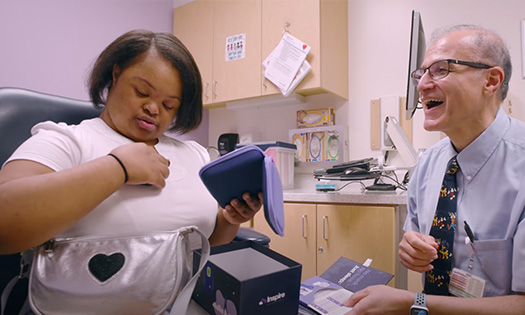An MRI without anesthesia? The mother of one of our patients had doubts, but her 6-year-old daughter was up for the challenge. She went in smiling and confident, and her pictures came out clear and crisp.
She’s one of the thousands of children who undergo an MRI scan without the need for anesthesia at Children’s Health℠ each year. This success is driven by our “Kids Can” program which combines patient education, clinical training and fun, interactive activities to help reduce the need for anesthesia, shorten procedure times and improve patient safety.
Drawbacks of Using Anesthesia
Although MRI eliminates the risks of ionizing radiation, the machine can be scary for children, sometimes requiring the use of sedation or general anesthesia to ensure patients remain calm and still for the duration of the procedure.
While this results in a still patient, anesthesia has its drawbacks. Longer pre-op and recovery times mean parents and kids miss more work and school. Anesthesia leaves many children feeling confused, nauseous and irritable during the recovery period. Additionally, there’s a recent concern around potential long-term risks with multiple or prolonged exposure to anesthetics in children under 3 years of age. Anesthesia is necessary in some children undergoing MRI, but doctors should do their best to avoid anesthesia when it’s not needed.
These challenges sent Tim Booth, M.D., Chief of Pediatric Radiology at Children’s Health and Professor of Radiology and Otolaryngology at UT Southwestern, searching for ways to avoid the use of anesthesia. He partnered with MRI technologists, radiologists and anesthesiologists to implement a screening process that identified patients who were more likely to complete a scan without anesthesia.
After seeing early success, the team decided to go all in. In February 2019, they brought on Stephanie Price, a Certified Child Life Specialist, to develop and lead the Kids Can program.
Preparation is Key for Sedation-Free MRI
Parents are asked to complete a questionnaire when they schedule their appointment. “We ask if their child has had an MRI before, how they respond to loud sounds and if they can hold still for a couple minutes,” Stephanie says. “These questions help us predict if patients can have a successful MRI without anesthesia.”
Patient education, the next step in the process, is the most important and is led by a child life specialist like Stephanie. Child life specialists have unique expertise in helping children understand and cope with illnesses, treatments and the stress that goes with them.
Stephanie tells the child what to expect during an MRI – from the sights and sounds to the layout of the room. She also emails audio clips of MRI sounds to parents, and encourages them and their children to practice holding still for minutes at a time while listening to them.
On the day of the MRI, Stephanie and the patient start the appointment with a fun and interactive practice session. Sometimes, they run a Barbie or superhero action figure through a mini MRI scanner. Other times patients don virtual reality goggles to simulate an actual MRI session. The motion-sensitive goggles alert the child if they move, allowing them to practice being still for two minutes at a time.
“It’s been a good use of our time to expose them to the environment beforehand,” Stephanie says. “They know how still they need to be before we get to the scanner, and we spend less time redoing sequences.”
If kids are still nervous, Stephanie brings out the program’s real MVP: a golden retriever named Boots. “He can lay on the bed, slide inside the bore and show them how to hold still,” Stephanie says. “They’re usually willing to get on the table once they’ve seen Boots do it!”
Gaining Buy-In from Parents and Providers
Stephanie and Dr. Booth have found that most kids are onboard – they see conquering MRIs as an achievement. It’s parents and physicians who can be a hard sell. “Physicians may have a tendency to believe that younger children cannot do the study without anesthesia” Dr. Booth says. “And parents don’t believe their kid can be still for minutes at a time.”
That’s why provider and parent education has been integral to the success of Kids Can. The team has hosted “lunch and learns” and presented at radiology department meetings to spread the word about the program’s success. They’ve also targeted parents by advertising the program through on-hold messages, website content and educational materials.
“When talking to parents, we emphasize that it’s not a 45-minute study,” Dr. Booth says. “Each sequence is in the two- to three-minute range. That’s very doable. We’ve had success with children as young as three.”
Empowering Kids to Be Successful
The Kids Can program has seen rapid growth and great success at Children’s Health. In fact, 90% of outpatient pediatric MRIs performed at our Pavilion Imaging Center are now performed without the need for anesthesia, compared to 40% prior to the creation of the program. Additionally, we have also seen an increase in positive patient satisfaction scores.
“Kids need adults around them saying, ‘You can do this. We believe in you,’” Stephanie says. “Instilling that confidence in a child will empower them to be successful. That’s what Kids Can is all about.”
Learn more about the culture of collaboration and innovation at Children’s Health.
Related podcast
Learn more about the Kids Can Program on the Pediatric Insights podcast


